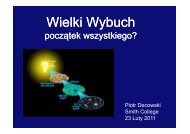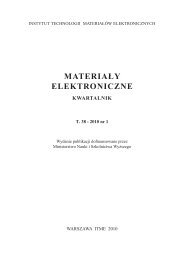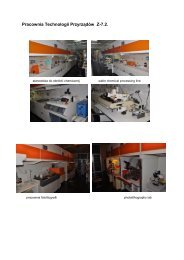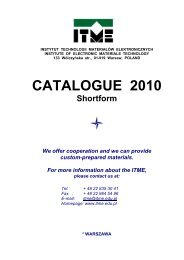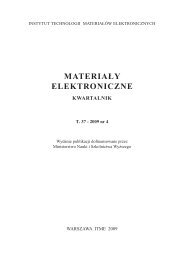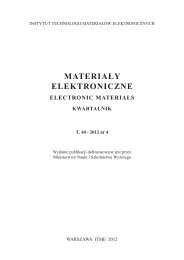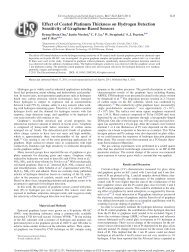MATERIAÅY ELEKTRONICZNE - ITME
MATERIAÅY ELEKTRONICZNE - ITME
MATERIAÅY ELEKTRONICZNE - ITME
Create successful ePaper yourself
Turn your PDF publications into a flip-book with our unique Google optimized e-Paper software.
Multifuncionality of multiferroic-based eutectic composites<br />
Fig. 1. The structure of ABX 3<br />
perovskite compounds is<br />
formed of cation A (red) in dodecahedral coordination<br />
(surrounded by 12 X anions (blue) e.g. oxygen) and cation<br />
B (green) in octahedral coordination (surrounded by<br />
6 anions).<br />
Rys. 1. Struktura związków typu ABX 3<br />
(sieć perowskitu)<br />
uformowana jest z kationów A (czerwone) umieszczonych<br />
w położeniu dodekahedrycznym (otoczonych<br />
12 anionami X (niebieskie), np. tlenem) oraz z kationu<br />
B (zielony) w położeniu oktaedrycznym (otoczony sześcioma<br />
anionami).<br />
They can be described as compounds with ABO 3<br />
general chemical formula, that crystallize in regular<br />
system - Pm-3m space group, although sometimes<br />
distorted to tetragonal or orthorhombic systems (the<br />
distortion is given quantitatively by the c/a ratio,<br />
where c and a correspond to cell parameters along<br />
z and x axis, respectively). The structural stability<br />
of perovskites is fairly well described by Goldschmidts<br />
rule:<br />
R A<br />
+ R O(-2)<br />
= t(R B<br />
+ R O(-2)<br />
)√2, where 0.8 < t < 1.0,<br />
R stands for the radius of a certain ion, while t<br />
is the constant, that describes the stability range for<br />
certain A and B cations. By using different cations<br />
(with charges summed to +6 and radii that will fit<br />
the upper equation) one can control a whole set of<br />
physical properties: dielectric and magnetic behaviour,<br />
the regularity of primary cell and others. When<br />
the condition is not fulfilled (the t constant exceeds<br />
the range) the high-symmetry structure<br />
(e.g. cubic, tetragonal, orthorombic) is considered<br />
unstable and gets distorted to low-symmetry forms<br />
(e.g. monoclinic).<br />
In the case of perovskites every single cell acts<br />
as a dielectric dipole. The structure itself enables the<br />
36<br />
dielectric polarization. The magnetic momentum can<br />
appear when a magnetic ion (like Fe +3 or Co +3 ) is<br />
placed in the octahedral position. Icosahedral positions<br />
are much larger, so there are very few magnetic<br />
cations that can match their size – Dy +3 , Yb +3 and<br />
usually their part in the effectice magnetic momentum<br />
is smaller than Fe +3 or Co +3 cations.<br />
The A cation will stand for a rare earth trivalent<br />
lanthanide ion (widely used, e.g. in the form of active<br />
dopants – Nd, Pr, Yb or compounds – YAG, GdCOB,<br />
YbAG). By changing the ion, spectroscopic properties<br />
can be modified very easily and the similarity<br />
between their radii should prevent high structural<br />
distortions, which may cause increased absorption<br />
of the material. The REFeO 3<br />
group of perovskites<br />
was found to act as weak ferromagnets (Tab 1.) and<br />
(ε’≈1000Fm -1 : GdFeO 3<br />
, f=10MHz 13 ) ferroelectrics.<br />
Table 1. Magnetization values of selected rare earth<br />
orthoferrites. 14<br />
Tabela 1. Wartości namagnesowania wybranych ortoferrytów<br />
metali ziem rzadkich.<br />
RE La Nd Gd Dy Yb<br />
4πM [Gauss] 83 62 94 128 143<br />
The stability of REFeO 3<br />
structure can be derived<br />
from Goldschmidts equation, which gives the maximum<br />
deviations of the A +3 ionic radius:<br />
For R Fe(+3)<br />
= 0.78 Å, R O(-2)<br />
= 1.4 Å [SHANNON],<br />
we have: 1.07 Å < R RE(+3)<br />
< 1.68 Å<br />
Typical rare earth ferrites, such as LaFeO 3<br />
,<br />
GdFeO 3<br />
or NdFeO 3<br />
show very good structural stability<br />
(R La(+3)<br />
= 1.36 Å, R Nd(+3)<br />
= 1.27 Å and R Gd(+3)<br />
= 1.11 Å). Smaller radius was found to increase the<br />
c/a factor (1.415 – LaFeO 3<br />
, 1.424 – NdFeO 3<br />
, 1.431<br />
– GdFeO 3<br />
) and to decrease the unit cell volume<br />
(242.93 Å 3 – LaFeO 3<br />
, 236.42 Å 3 – NdFeO 3<br />
, 230.07<br />
Å 3 – GdFeO 3<br />
). The denser packing can be clearly<br />
distinguished macroscopically in enhanced hardness<br />
of such materials. It is more difficult to polish<br />
GdFeO 3<br />
than LaFeO 3<br />
.<br />
An exact REFeO 3<br />
stoichiometry is very difficult<br />
to achieve, due to partial reduction of iron to divalent<br />
Fe +2 . That in exchange causes oxygen vacancies to<br />
appear and increases the ionic conductivity of the<br />
material, as well as increases its absorption. Crystals<br />
are often opaque with reddish-brown or black<br />
colouration.<br />
It turns out that REFeO 3<br />
perovskites give away<br />
oxygen very easily as long as the loss is quickly compensated,<br />
for example when one side of the sample is<br />
partially reduced, (due to combustion of a gas with<br />
the help of the “lattice” oxygen) oxygen vacancies<br />
are generated and by the means of diffusion travel




